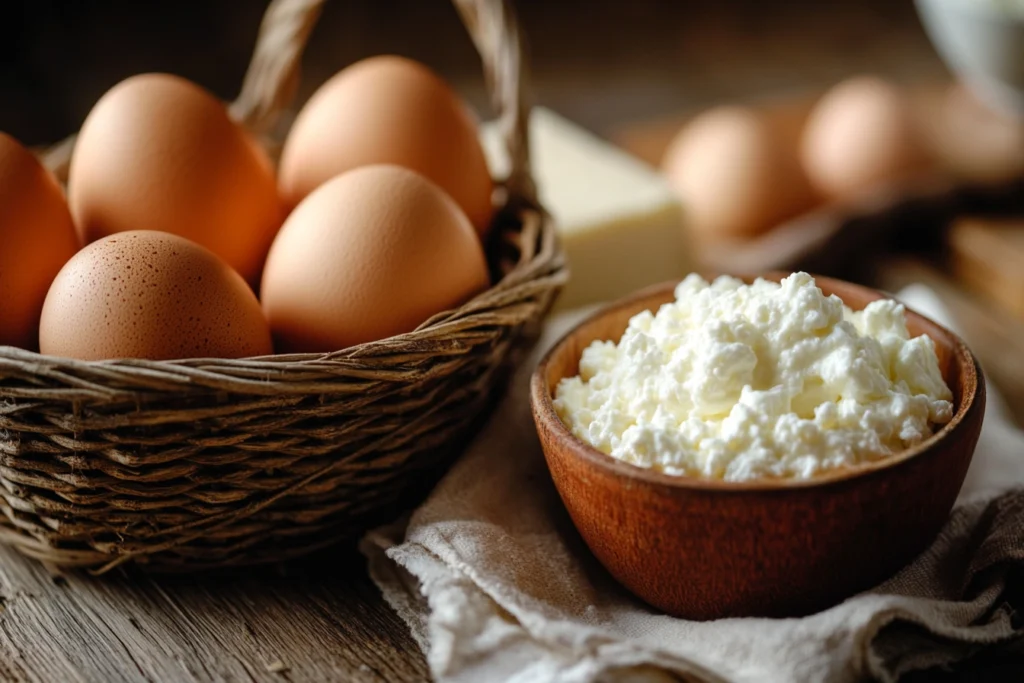Cooking eggs with cottage cheese should create a creamy, protein-packed dish, but many cooks encounter the frustrating issue of watery eggs with cottage cheese. This common problem affects texture and presentation, leaving the dish unappetizing. Understanding why this happens and how to fix it is crucial for achieving the perfect balance of flavors and consistency.

Table of Contents
Why Understanding the Science Behind This is Essential
Knowing the science of watery eggs with cottage cheese helps you control the outcome. Cottage cheese contains water and whey, which separate when exposed to heat. Eggs are sensitive to moisture and require precision in cooking to retain their binding properties.
Understanding the Problem
What Are Watery Eggs?
Watery eggs occur when excess liquid pools in your dish rather than incorporating into the ingredients. Characteristics include:
- A thin, unappealing layer of water around the eggs.
- A lack of structure or firmness in the cooked product.
This issue impacts texture, flavor, and visual appeal, making your meal less enjoyable.
How Watery Eggs Affect the Final Dish
The excess liquid disrupts the creamy consistency you expect from combining eggs and cottage cheese. Instead of a smooth, rich dish, you’re left with a runny mess that fails to satisfy.
Why Does It Happen?
Chemistry of Eggs and Cottage Cheese
Eggs are delicate proteins that solidify with heat. However, when combined with cottage cheese, the water content disrupts this process. The eggs struggle to bind effectively, resulting in watery eggs with cottage cheese.
Moisture Content in Cottage Cheese
Cottage cheese is approximately 80% water. Without proper preparation, this high moisture content directly contributes to the watery consistency of your dish.
Cottage Cheese and Eggs: A Delicate Balance
The Role of Cottage Cheese
Cottage cheese offers numerous benefits, including:
- High protein content for a nutritious meal.
- A creamy texture that enhances egg dishes.
However, its moisture level must be managed to prevent undesirable results.
How Eggs Interact with Other Ingredients
Eggs act as binders, holding the dish together. When combined with wet ingredients like cottage cheese, their ability to solidify diminishes, creating watery eggs with cottage cheese.
Factors Contributing to Watery Eggs

Quality of Ingredients
- Freshness of Eggs: Fresh eggs have a firmer structure, which helps combat excess moisture.
- Type of Cottage Cheese: Low-moisture or dry-curd varieties work best to reduce water content.
Cooking Techniques
Heat management is critical. Cooking eggs too quickly or at excessively high temperatures can cause proteins to break down, releasing water.
Proportions Matter
Too much cottage cheese relative to eggs overwhelms the mixture, leading to a higher likelihood of watery eggs with cottage cheese. A balanced ratio is essential for success.
How to Prevent Watery Eggs
Tips for Choosing Ingredients
- Select Low-Moisture Cottage Cheese: Opt for brands labeled as “dry-curd” to reduce water content.
- Use Fresh Eggs: Fresh eggs maintain their structure better and produce less water.
Adjusting Recipes
- Experiment with different ratios of eggs to cottage cheese. A 3:1 ratio often works well.
- Add a thickening agent like cornstarch or flour to absorb excess moisture.
Cooking Tips for Perfect Results
- Cook over low to medium heat for even cooking.
- Stir frequently to distribute heat and moisture uniformly.
- Use non-stick cookware for better control.
Common Mistakes and How to Avoid Them
Adding Cottage Cheese Directly
Without draining, cottage cheese contributes too much liquid. Always strain it using a fine-mesh sieve or cheesecloth before mixing it with eggs.
For more on handling ingredients, see our guide on common baking substitutions.
Not Whisking Thoroughly
An uneven mixture of eggs and cottage cheese results in watery eggs. Whisk the ingredients until fully combined for a consistent texture.
Cooking at Incorrect Temperatures
High heat breaks down proteins, causing them to release water. Stick to low and steady heat for optimal results.
Learn about ideal cooking methods from our article on why baked eggs can turn rubbery.
Best Recipes to Try with Eggs and Cottage Cheese
Classic Scrambled Eggs with Cottage Cheese
- Whisk three eggs with half a cup of drained cottage cheese.
- Cook over medium heat, stirring constantly for creamy, non-watery scrambled eggs.
Cottage Cheese Omelet
- Combine eggs, cottage cheese, and spinach for a nutritious omelet.
- Cook slowly to allow the eggs to set without becoming watery.
Healthy Breakfast Casserole
- Layer eggs, cottage cheese, and vegetables in a baking dish.
- Bake at 350°F until the center is firm for a hearty, moisture-controlled breakfast.
Explore similar recipes, such as Healthy Baking Tips for Breakfast, for additional inspiration.
Common Mistakes and How to Avoid Them
Adding Cottage Cheese Directly
When making dishes with watery eggs with cottage cheese, one common mistake is adding cottage cheese straight from the container. Cottage cheese contains a significant amount of liquid, which separates during cooking and results in watery eggs. Draining cottage cheese before use is crucial to prevent this issue.
Why does draining matter? Cottage cheese is packed with whey and water, which can disrupt the balance in your egg mixture. To address this, use a fine-mesh strainer or cheesecloth to remove excess moisture. Once drained, the cottage cheese will blend better with the eggs, leading to a creamier texture and improved consistency.
Failing to remove the water content can compromise the structure of the eggs, making them runny and less enjoyable. By taking the time to drain, you can ensure a more professional-quality dish that avoids this common pitfall.
Not Whisking Thoroughly
Another key mistake leading to watery eggs with cottage cheese is insufficient whisking. Properly mixing your ingredients is critical for achieving a smooth and uniform texture. When cottage cheese and eggs are not evenly combined, pockets of moisture from the cheese can form, resulting in a runny consistency.
Thorough whisking helps to evenly distribute the cottage cheese throughout the eggs. It also incorporates air, which can improve the fluffiness of the final dish. Use a whisk or fork to mix the ingredients until the mixture appears uniform and slightly frothy.
Additionally, take your time during this step. A rushed mix can leave clumps of cottage cheese or eggs that fail to bind properly. Consistency is key, and ensuring a smooth mixture will help you avoid watery results while enhancing the texture of your dish.
Cooking at Incorrect Temperatures
Temperature plays a vital role in avoiding watery eggs with cottage cheese. Cooking at the wrong temperature can cause the eggs to release water. High heat often breaks down the proteins in the eggs too quickly, while low heat gives them time to set correctly.
Using low and steady heat is the best approach. High heat might seem faster, but it can cause the eggs to overcook on the outside while remaining undercooked and watery on the inside. To achieve perfect results, maintain a medium-low temperature and cook slowly.
Cooking eggs gently allows the proteins to coagulate gradually, absorbing moisture instead of releasing it. This results in a creamier texture and eliminates the pooling of water. Invest in a good-quality non-stick pan, as it distributes heat evenly and ensures better control during cooking.
Best Recipes with Eggs and Cottage Cheese

Classic Scrambled Eggs with Cottage Cheese
This recipe for scrambled eggs with cottage cheese ensures a creamy and protein-packed breakfast.
- Whisk together three eggs and ¼ cup of drained cottage cheese.
- Add salt and pepper to taste, and mix thoroughly.
- Heat a non-stick pan over medium-low heat and add a small amount of butter or oil.
- Pour the mixture into the pan and cook slowly, stirring constantly until the eggs are fluffy and set.
The result is a light and creamy dish without the issue of watery eggs with cottage cheese. Always remember to cook at a controlled temperature for optimal results.
Cottage Cheese Omelet
A cottage cheese omelet is a versatile dish that combines flavor and nutrition. Here’s how to make it:
- Whisk two eggs with 2 tablespoons of drained cottage cheese.
- Add chopped vegetables like spinach, tomatoes, or bell peppers for added texture.
- Heat a pan on low heat, and pour in the mixture.
- Cook until the eggs are mostly set, then fold the omelet in half.
This method minimizes moisture while enhancing the dish’s richness. The cottage cheese melts slightly, giving the omelet a creamy center without being watery.
Healthy Breakfast Casserole
For a hearty and balanced meal, a breakfast casserole is an excellent choice.
- Preheat your oven to 350°F (175°C).
- Combine six eggs, 1 cup of drained cottage cheese, and your choice of chopped vegetables in a bowl.
- Add cooked sausage or turkey for extra protein.
- Pour the mixture into a greased baking dish and bake for 25–30 minutes until the center is firm.
This recipe balances moisture and flavor, ensuring that the casserole remains fluffy without excess water.
Expert Advice on Cooking Eggs and Cottage Cheese
Chef-Approved Tips
Professional chefs emphasize the importance of ingredient preparation and technique when avoiding watery eggs with cottage cheese. Some key tips include:
- Always drain your cottage cheese before mixing.
- Use room-temperature eggs for better blending and even cooking.
- Stir frequently during cooking to ensure a consistent texture.
These small adjustments can make a significant difference in the quality of your dish.
Science-Backed Insights
Understanding the science behind watery eggs with cottage cheese can improve your results. Eggs are primarily protein, and their structure changes when heated. Too much water from cottage cheese interferes with this process, preventing the eggs from binding properly.
By draining the cheese and controlling heat, you allow the proteins to coagulate correctly. This balance results in a smooth, creamy texture free of water.
Conclusion
Avoiding watery eggs with cottage cheese is achievable with proper techniques and preparation. Draining cottage cheese, whisking thoroughly, and cooking at a steady temperature are essential steps. With these methods, you can create rich, flavorful dishes that showcase the best of both ingredients. Experiment with recipes, and enjoy the perfect balance of texture and taste.
FAQs
1. Why are my eggs and cottage cheese watery?
Watery eggs and cottage cheese can result from excessive moisture content, incorrect cooking techniques, or ingredient separation.
Eggs: Overbeating, cooking at too low a temperature, or using old eggs can cause them to release excess water.
Cottage Cheese: Some brands have a higher liquid content, or the cheese may have separated over time due to storage conditions.
2. How to fix watery scrambled eggs?
Use fresh eggs – Older eggs tend to release more liquid.
Cook over medium heat – High heat can make eggs tough, while too low heat can make them watery.
Stir frequently – Gently folding eggs instead of stirring aggressively prevents them from becoming runny.
Add dairy properly – Avoid too much milk, cream, or watery cottage cheese. Opt for thick dairy like heavy cream or Greek yogurt.
Drain excess moisture – If using cottage cheese, strain it before mixing it into eggs.
3. What does cottage cheese do to eggs?
Cottage cheese adds creaminess, protein, and a slightly tangy flavor to eggs. It can make scrambled eggs richer and fluffier, but if it contains too much liquid, it may cause eggs to become watery. Straining it beforehand helps prevent this issue.
4. What causes watery eggs?
Overcooking – Cooking eggs too long can cause protein breakdown, releasing water.
Old eggs – Older eggs lose structure and tend to release more liquid.
Low cooking temperature – Slow cooking can allow excess moisture to separate.
High moisture ingredients – Adding too much milk, watery cheese, or veggies can increase water content.


1 thought on “Watery Eggs with Cottage Cheese: Common Mistakes & Easy Fixes”